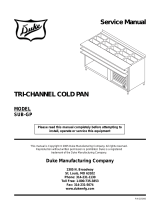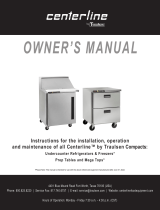
V. REMOVAL & REPLACEMENT OF PARTS (cont’d)
WARNING: UNPLUG UNIT BEFORE SERVICING
V. d - DOOR GASKET:
Begin by removing the old gasket by pulling it out from
the gasket retainer.
Begin installing the new gasket by installing the four
corners first, pushing straight into the gasket until it
is hooked behind the gasket retainer (see figure 9).
Next, starting at the center of one edge, push the door
gasket straight in until it is hooked behind the gasket
retainer (see figure 10).
Proceeding from this point out to the corners, con-
tinue to push the gasket straight into the gasket re-
tainer.
Continue to the remaining edges and repeat the pre-
ceding operations until installation is completed.
Plug in the unit and put back into operation.
CAUTION:
Do Not Pull on the gasket material. This
will stretch it and, at room temperature, the material
will NOT return to its original length.
V. e - DOOR:
Begin by removing the old door. Open it to the maxi-
mum position, placing support under the non-hinged
end of the door so minimum movement occurs when
bolts from the lower hinge are removed (see figure 11).
Remove the bolts from the lower hinge plate and pro-
ceed to remove the door from the top hinge bracket.
The hinge plate pin and plastic bushing will remain in
the top hinge plate.
To install, position the lower hinge plate into the posi-
tion of being open 90 degrees to the cabinet. Place
the top hinge plate pin in the hole in the top of the
door and support the other end of the door for mini-
mal movement.
Start the bolts in the lower hinge plate and tighten the
bolts enough to hold the door in place. Remove the
support from under the end of the door.
Adjust the door as outlined in “section VI. h.”
V. f - DOOR HINGE MECHANISM:
Begin by removing the door as outlined above. Lay
the door flat on a padded surface to prevent damage.
Remove the screw that holds the lower hinge plate to
the hinge mechanism stem.
NOTE: When installing, make sure the hinge mecha-
nism stem is in a position where there is tension on
the stem when turned in either direction.
-7- -16-
VI. SERVICE PROCEDURES & ADJUSTMENTS
WARNING: CERTAIN PROCEDURES IN THIS SECTION REQUIRE ELECTRICAL TEST OR MEASUREMENTS WHILE
POWER IS APPLIED TO THE MACHINE. EXERCISE EXTREME CAUTION AT ALL TIMES. IF TEST POINTS ARE
NOT EASILY ACCESSIBLE, DISCONNECT POWER, ATTACH TEST EQUIPMENT AND REAPPLY POWER TO TEST.
VI. a -
SYSTEM ACCESS:
All external indicators should be checked as part of
system diagnosis before determining the refrigerant
pressures. Improper access may expose the refriger-
ant to contaminates and non-condensables which will
result in system failure.
VI. b - BOLT-ON PIERCING VALVES:
CAUTION: Bolt-on piercing valves are used as a tem-
porary diagnostic tool. They must be removed from
the system before the system is put back into opera-
tion.
1) Place one piercing valve on the compressor pro-
cess tube and one on the liquid line drier process tube.
Follow the installation instructions provided by the
manufacturer of the piercing valve.
2) Upon completion of diagnosis, pinch off the pro-
cess tube just below the piercing valve.
3) Remove the valve and sweat the opening shut.
4) Install permanent access fittings in the suction and
liquid lines as part of system repair.
5) When complete, follow the guidelines as outlined
under “LEAK CHECK” and “EVACUATING SYSTEM.”
VI. c - SWEAT-ON PIERCING VALVES:
NOTE: Sweat-on piercing valves are used for system
diagnostics, but may be left on after service is com-
plete. They may be installed while the system is fully
charged.
1) Place one piercing valve on the compressor pro-
cess tube and one on the liquid line drier process tube.
Follow the installation instructions provided by the
manufacturer of the piercing valve.
2) When complete, follow the guidelines as outlined
under “LEAK CHECK” and “EVACUATING SYSTEM.”
VI. d - REFRIGERANT LEAK CHECK:
DISCONNECT THE ELECTRICAL POWER TO THE
MACHINE AT THE MAIN CIRCUIT BOX. PLACE A TAG
ON THE CIRCUIT BOX INDICATING THE CIRCUIT IS
BEING SERVICED.
THIS PROCEDURE REQUIRES THE USE OF REFRIG-
ERANTS. BE CERTAIN THE WORK AREA IS WELL
VENTILATED. SAFETY GOGGLES AND GLOVES
SHALL BE WORN SINCE REFRIGERANTS MAY CAUSE
BURNS TO THE SKIN.
NOTE: The use of R-22 in small quantities is recom-
mended as a trace gas for leak detection.
VI. d - REFRIGERANT LEAK CHECK (cont’d):
1) Access the refrigeration system (note: see section
“VI. a - SYSTEM ACCESS”).
2) Attach gauge manifold set to the system, low side
to process tube on the compressor and the high side
to the process tube on the drier.
3) Connect refrigerant bottle to the center of gauge
manifold and open the valve on the bottle. Bleed charg-
ing hose at the manifold gauge to remove air from the
system.
4) Open valve on low side of gauge manifold and
charge system with one ounce of R-22.
5) Close low side of the gauge manifold and the valve
on the refrigerant bottle.
6) Disconnect refrigerant bottle and connect nitrogen
bottle.
NOTE: The use of a nitrogen requlator is required.
7) Set output valve on nitrogen valve to 120 psi.
8) Open nitrogen bottle valve and low side gauge mani-
fold valve. Allow pressure to equalize.
9) Shut off both valves and disconnect nitrogen bottle.
10) Use a leak detector or a thick soapy solution and
check for leaks at all tubing connections.
A - If leaks are found, repair leaks and repeat process.
B - If no leaks are found, evacuate system as outlined
in section “VI. e - EVACUATING SYSTEM”.
11) Charge the system and check for proper opera-
tion.
VI. e - EVACUATING SYSTEM:
Introduction - Refrigeration reclaiming equipment is
required. Our goal in system evacuation is to remove
all the non-condensables possible. No evacuation
method will remove 100% of the moisture and air from
within the refrigeration circuit. Because of this, guide-
lines and methods must be developed and adhered to
ensuring only harmless amounts of contaminants re-
main in the system.
GUIDELINES
WARNING - DO NOT PRESSURIZE SYSTEM ABOVE
150 PSIG. PRIOR TO EVACUATION OR DURING LEAK
TEST PROCEDURES.
• Use only a two stage vacuum pump (2 CFM or
greater) and electronic micron.
• Evacuate from high and low sides of the system.
• No chemical additive or alcohols are to be used to
“dry up” a system.





















